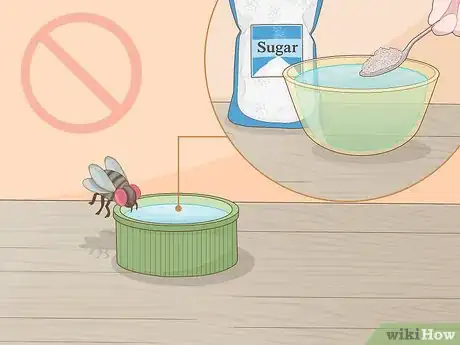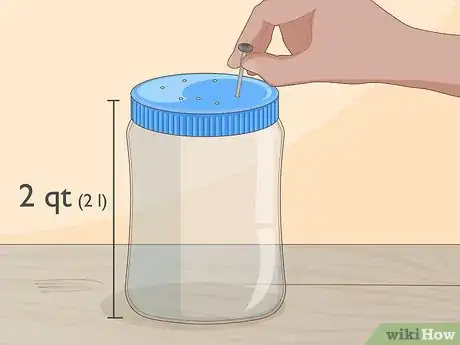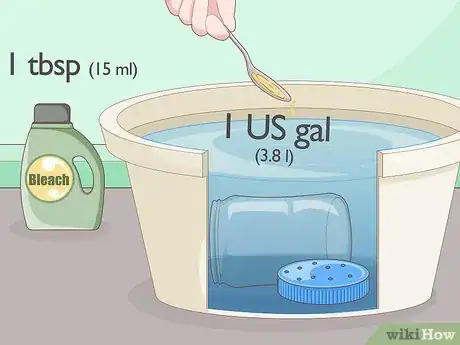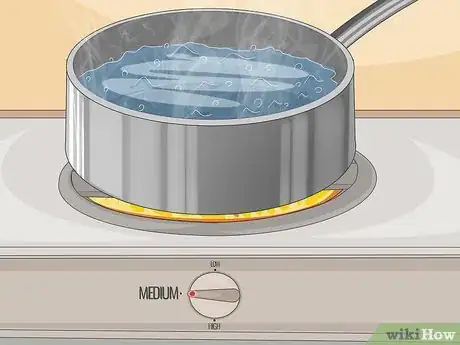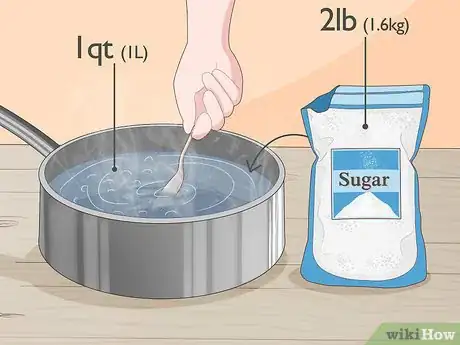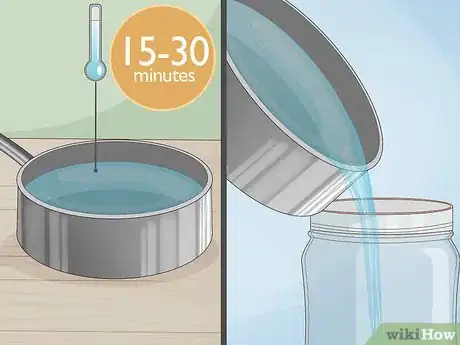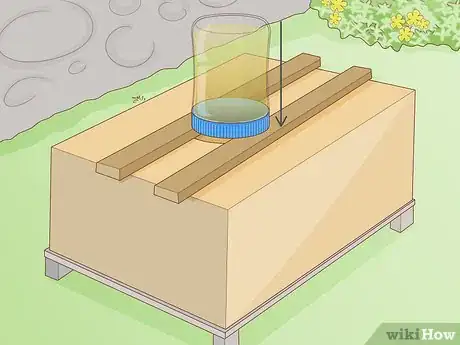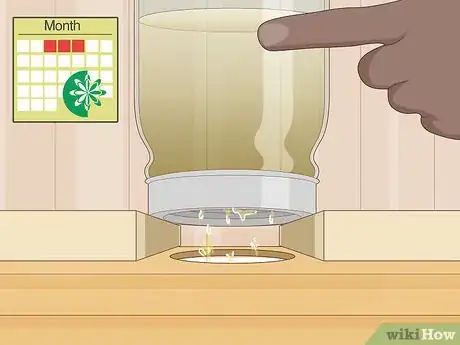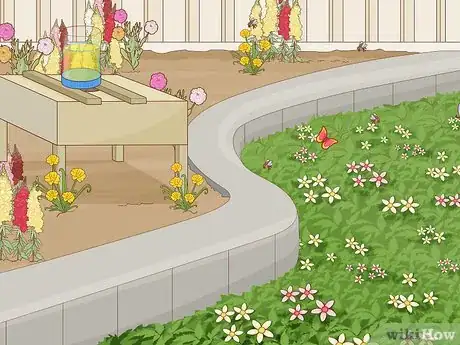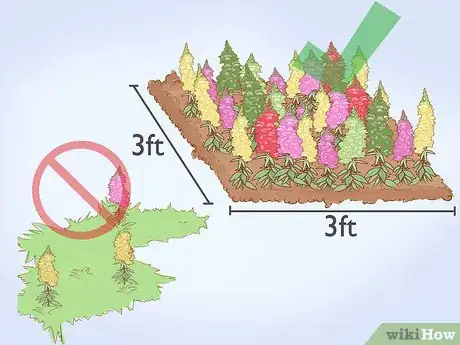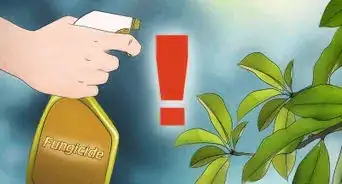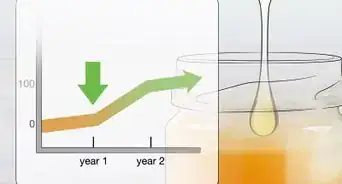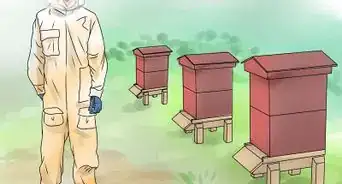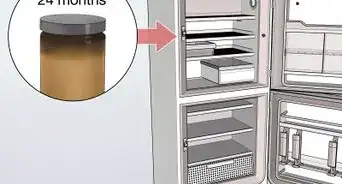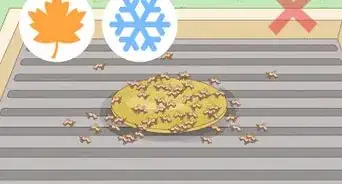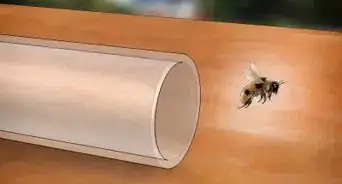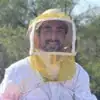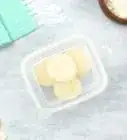This article was co-authored by Steve Downs and by wikiHow staff writer, Amy Bobinger. Steve Downs is a Live Honey Bee Removal Specialist, Honey bee Preservationist, and the Owner of Beecasso Live Bee Removal Inc, a licensed bee removal and relocation business based in the Los Angeles, California metro area. Steve has over 20 years of humane bee capturing and bee removal experience for both commercial and residential locations. Working with beekeepers, agriculturalists, and bee hobbyists, Steve sets up bee hives throughout the Los Angeles area and promotes the survival of bees. He has a passion for honeybee preservation and has created his own Beecasso sanctuary where rescued bee hives are relocated and preserved.
There are 7 references cited in this article, which can be found at the bottom of the page.
This article has been viewed 77,394 times.
Feeding a bee sugar water off a spoon makes for a cute image, but bee experts generally advise against feeding sugar water to a bee you stumble across. However, some trained beekeepers do feed bees sugar water in particular cases, often to give a "boost" to a new beehive or to help out a hive in the middle of winter. Luckily, if you believe your colony needs an additional food source, making your own sugar water and feeder is easy.[1]
Steps
Using Sugar Water as a Beekeeper
-
1Do not feed sugar water to bees if they have natural nectar or stored honey. If you give the bees easy access to a food source like sugar water, they won't go out foraging for nectar, which they have to work for. Since bees turn nectar into honey, over time their honey production will diminish or stop altogether if they come to rely on the sugar water.[2]
- Not only will a steady supply of sugar water affect the honey supply, but the bees may start to store it along with their honey, making the honey unsuitable to consume.
- To check your hive's store of honey, gently tilt the beehive forward. If it feels very light, there's no honey inside.
- In addition to supplying food for hungry bees, you may also choose to offer sugar water to help establish a new hive of bees or if you need to rear a new queen for one of your hives.
-
2Punch 6-8 very small holes in the lid of a canning jar or airtight container. If you have a commercial bee feeder, you can use that, but if you don't, you can easily make your own out of a canning jar or any other container with an airtight lid. Use the tip of a framing nail or a similar small, sharp object to make several tiny holes in the top of the lid.
- When you feed the bees, you'll turn the jar upside-down and the bees will drink the sugar water through the holes. If the holes are small enough, a vacuum will form in the jar, which will prevent the sugar water from dripping out.
- Use a 2 qt (2 l) jar for smaller batches, such as feeding the bees during the spring. However, if you'll be feeding the bees during the late fall or winter, opt for a container that will hold about 5 qt (5 l).
Advertisement -
3Sterilize the pot, container, and any equipment you'll be using in bleach water. Fill your sink or a large container with enough water to completely cover the pot. Then, carefully add approximately 1 tbsp (15 ml) of bleach for every 1 US gal (3.8 l) of water that you used. Soak your pot, the container or feeder you're using, the lid, a measuring cup, and a long-handled spoon in the bleach mixture for 1-5 minutes, then rinse everything thoroughly with fresh water.[3]
- For instance, if you're planning to make the sugar water in a large stockpot, you may need about 5 US gal (19 l) of water. You'd then add 5 US tbsp (74 mL) of chlorine bleach to the water.
- It's very important to make sure you kill any bacteria that could be living on the surface of the pot and the container that you'll use. Bees are very susceptible to illness, so if you introduce bacteria into the hive, you could kill them.
Warning: Be very careful not to splash any bleach into your eyes when you're measuring it, and avoid letting undiluted bleach contact your skin.
-
4Bring a pot of water to a near-boil on your stovetop. After you've sterilized your equipment, measure your water and pour it into the pot, then heat it on medium-high until the first few bubbles start to break on the surface, However, avoid letting the water come to a full boil, as it could crystallize the sugar when you add it.[4]
- To feed bees in the early spring or when you're queen-rearing, give them about 2 quarts (2 liters) of a 1:1 concentration of sugar and water, so start with about 1 quart (1 liter) of water. Replace the mixture every few days until natural nectar is available.
- If you're feeding the bees in the late fall or winter, prepare a 2:1 mixture of sugar to water, and feed the bees 5-10 quarts (5-10 liters) each week. For example, to make a 6 quart (6 l) mixture, start with about 2 quarts (2 liters) of water.
Did You Know? Since liquid and dry goods are measured differently, the easiest way to scale your ratio is by using the weight of the water and sugar. 1 quart (1 liter) of water weighs approximately 2 lb (0.91 kg), and 8 cups of sugar is about 2 lb (0.91 kg).
-
5Remove the water from the heat, then stir in plain white sugar. Just before the water comes to a boil, take the pan off of the heat. Then, measure and pour in white cane sugar, stirring constantly until it's completely dissolved.[5]
- If you're making 2 quarts (2 liters) of a 1:1 mixture and you started with 1 qt (1 l) of water, add 2 lb (1.6 kg) of sugar, or about 8 cups.
- If you're making 6 qt (6 l) of a 2:1 mixture, you would add about 8 lb (3.6 kg) of sugar, or about 16 cups.
- White cane sugar is inexpensive and dissolves well, making it ideal for feeding bees. Organic and raw sugar can both be used, but they're more expensive and may be a little harder for the bees to digest.[6]
-
6Let the syrup cool for about 15-30 minutes, then carefully pour it into your feeder. The mixture will be somewhat syrupy, so pour slowly. Also, try not to spill any syrup on the outside of the container, as the sugar may attract ants.[7]
- Larger batches of syrup may need longer to cool. The outside of the pot should be comfortable to handle before you pour it.
- If you're using a commercial bee feeder, follow the manufacturer's instructions for filling it.
-
7Place the container upside-down on spacers in the top of your hive. Lift the lid off the top of your beehive and place 2 small wooden sticks inside of it. These will create a space between the hive and the top of the jar, allowing the bees to reach the sugar water. Place the feeder on top of the spacers, then replace the lid on your hive.[8]
- You can also purchase feeding frames that will hold your feeder for you.
-
8Adjust your feedings based on how quickly the bees consume the sugar water. If you're feeding the bees during the spring, or if you're queen-rearing, check the sugar water every 2-3 days, or check about once a week during cooler weather. If there's any of the syrup left, you may need to feed them less next time.[9]
Making Your Yard Hospitable to Bees
-
1Avoid using pesticides in your yard, especially neonicotinoids. Bees are very sensitive to pesticides, so if you want to attract bees to your yard, opt for natural methods of insect and weed removal. Neonicotinoids are a type of pesticide that's especially fatal to bees, and they can quickly wipe out your entire hive.[10]
- Buy organic plants or grow your own to avoid nursery plants treated with insecticide.
-
2Plant a variety of wildflowers and local plants in your garden. Bees need both pollen and nectar, so including a wide range of plants in your garden will help ensure they have the biodiversity they need. Try to find small, medium, and large flowers, and opt for varieties that thrive in your area to ensure your plants are hardy enough to support your beehive.[11]
- Plants like lavender, oregano, and thyme can help bees fight off mites which may spread diseases to the colony.
- Talk to a local bee expert or botanist, or do a search online to find bee-attracting plants that are native to your area.
- If you live in North America, the UK, Switzerland, France, Singapore, Kenya, Australia, or New Zealand, you can visit the Xerces Society's website for a list of pollinator-friendly plants by going to http://xerces.org/pollinator-conservation/plant-lists/.
Did You Know? Pollen provides protein to bees, while nectar gives them carbohydrates.[12]
-
3Select plants that flower at different times of the year. In order for your bees to be healthy, they should have access to flowering plants from early spring through about mid-autumn. When you're choosing your plants, try to plan the flowering times so they'll stretch over as many seasons as possible.[13]
- If you only choose plants that flower in early spring, for instance, you'll have hungry bees in the late summer when the early blooms are starting to fade.
-
4Plant your flowers in large groupings. If you plant your flowers in large clumps, they'll be easier for the bees to find than if you were to spread them out sparsely. Try to plan out sections of flowers that will bloom at about the same time.[14]
- For instance, you might plant sections of similar blooms in about 3 ft × 3 ft (0.91 m × 0.91 m) clumps.
-
5Allow some weeds to grow in your yard. Wildflowers and weeds can be extremely beneficial to bees, especially plants like dandelions and clovers. If you can, try to pick a section of your yard that you don't mow regularly.[15]
- These native plants will not only support your beehives, but they'll likely draw in wild bees from your area, so you'll be helping a variety of different bee species to thrive.
Expert Q&A
-
QuestionHow do you make sugar water for bees?
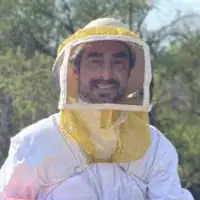 Steve DownsSteve Downs is a Live Honey Bee Removal Specialist, Honey bee Preservationist, and the Owner of Beecasso Live Bee Removal Inc, a licensed bee removal and relocation business based in the Los Angeles, California metro area. Steve has over 20 years of humane bee capturing and bee removal experience for both commercial and residential locations. Working with beekeepers, agriculturalists, and bee hobbyists, Steve sets up bee hives throughout the Los Angeles area and promotes the survival of bees. He has a passion for honeybee preservation and has created his own Beecasso sanctuary where rescued bee hives are relocated and preserved.
Steve DownsSteve Downs is a Live Honey Bee Removal Specialist, Honey bee Preservationist, and the Owner of Beecasso Live Bee Removal Inc, a licensed bee removal and relocation business based in the Los Angeles, California metro area. Steve has over 20 years of humane bee capturing and bee removal experience for both commercial and residential locations. Working with beekeepers, agriculturalists, and bee hobbyists, Steve sets up bee hives throughout the Los Angeles area and promotes the survival of bees. He has a passion for honeybee preservation and has created his own Beecasso sanctuary where rescued bee hives are relocated and preserved.
Live Bee Removal Specialist To make sugar water, just dissolve organic sugar in hot water. You can also add supplements to the water for more nutrients. For example, you can add some bee pollen to give the bees more protein, which will help keep them robust during the winter.
To make sugar water, just dissolve organic sugar in hot water. You can also add supplements to the water for more nutrients. For example, you can add some bee pollen to give the bees more protein, which will help keep them robust during the winter. -
QuestionCan I feed them with sugar water in the fall even though the supers are still in place with honey in them?
 XxSariaxxCommunity AnswerIn moderation, yes. However, be careful not to give them too much sugar water, it lacks most of the nutrients they need to survive and is only meant as a "booster."
XxSariaxxCommunity AnswerIn moderation, yes. However, be careful not to give them too much sugar water, it lacks most of the nutrients they need to survive and is only meant as a "booster." -
QuestionHow do I attract bees?
 Community AnswerYou'll find good tips for doing so in Attract Honey Bees.
Community AnswerYou'll find good tips for doing so in Attract Honey Bees.
Warnings
- You should only feed sugar water to bees if you are an experienced beekeeper. It should only be used in situations where the bees need a supplemental food source in order to ensure their survival.⧼thumbs_response⧽
Things You'll Need
- Bleach
- Water
- Pot
- Canning jar or airtight container
- Measuring cup
- Long-handled spoon
- 2 wooden sticks
References
- ↑ http://www.nationalbeeunit.com/downloadDocument.cfm?id=741
- ↑ https://www.dpi.nsw.gov.au/__data/assets/pdf_file/0018/532260/Feeding-sugar-to-honey-bees.pdf
- ↑ http://ucfoodsafety.ucdavis.edu/files/26437.pdf
- ↑ https://www.dpi.nsw.gov.au/__data/assets/pdf_file/0018/532260/Feeding-sugar-to-honey-bees.pdf
- ↑ http://agriculture.vic.gov.au/agriculture/livestock/honey-bees/compliance-and-management/feeding-honey-bee-colonies-to-prevent-starvation
- ↑ https://www.dpi.nsw.gov.au/__data/assets/pdf_file/0018/532260/Feeding-sugar-to-honey-bees.pdf
- ↑ https://www.dpi.nsw.gov.au/__data/assets/pdf_file/0018/532260/Feeding-sugar-to-honey-bees.pdf
- ↑ https://www.dpi.nsw.gov.au/__data/assets/pdf_file/0018/532260/Feeding-sugar-to-honey-bees.pdf
- ↑ http://agriculture.vic.gov.au/agriculture/livestock/honey-bees/compliance-and-management/feeding-honey-bee-colonies-to-prevent-starvation
- ↑ https://www.cbc.ca/news/canada/british-columbia/10-tips-for-creating-a-bee-friendly-garden-1.3580095
- ↑ https://www.cbc.ca/news/canada/british-columbia/10-tips-for-creating-a-bee-friendly-garden-1.3580095
- ↑ https://twin-cities.umn.edu/news-events/being-friend-bees
- ↑ https://foecanada.org/en/2017/04/help-save-the-bees/
- ↑ https://foecanada.org/en/2017/04/help-save-the-bees/
- ↑ https://www.cbc.ca/news/canada/british-columbia/10-tips-for-creating-a-bee-friendly-garden-1.3580095
- ↑ http://agriculture.vic.gov.au/agriculture/livestock/honey-bees/compliance-and-management/feeding-honey-bee-colonies-to-prevent-starvation
About This Article
If your new bee colony doesn’t have access to natural nectar or stored honey, you can feed them homemade sugar water to keep them healthy. During the early spring, you’ll want to mix 1 liter of water with 8 cups of plain white sugar. During the late fall or winter, mix 2 liters of water with 8 cups of sugar, since they won’t need as much sugar. To make the sugar water, you’ll want to bring a pot of water nearly to a boil, then take it off the heat and mix in your sugar. Then, leave it to cool for 15 to 30 minutes. To make a suitable feeder, you’ll need to punch 6 to 8 tiny holes in the lid of a canning jar or airtight container and sterilize the container with boiling water. Fill the container with your cool sugar water and place it upside-down on the spacers in the top of your hive. For more tips, including how to adjust your sugar water based on the bees’ feeding habits, read on!
